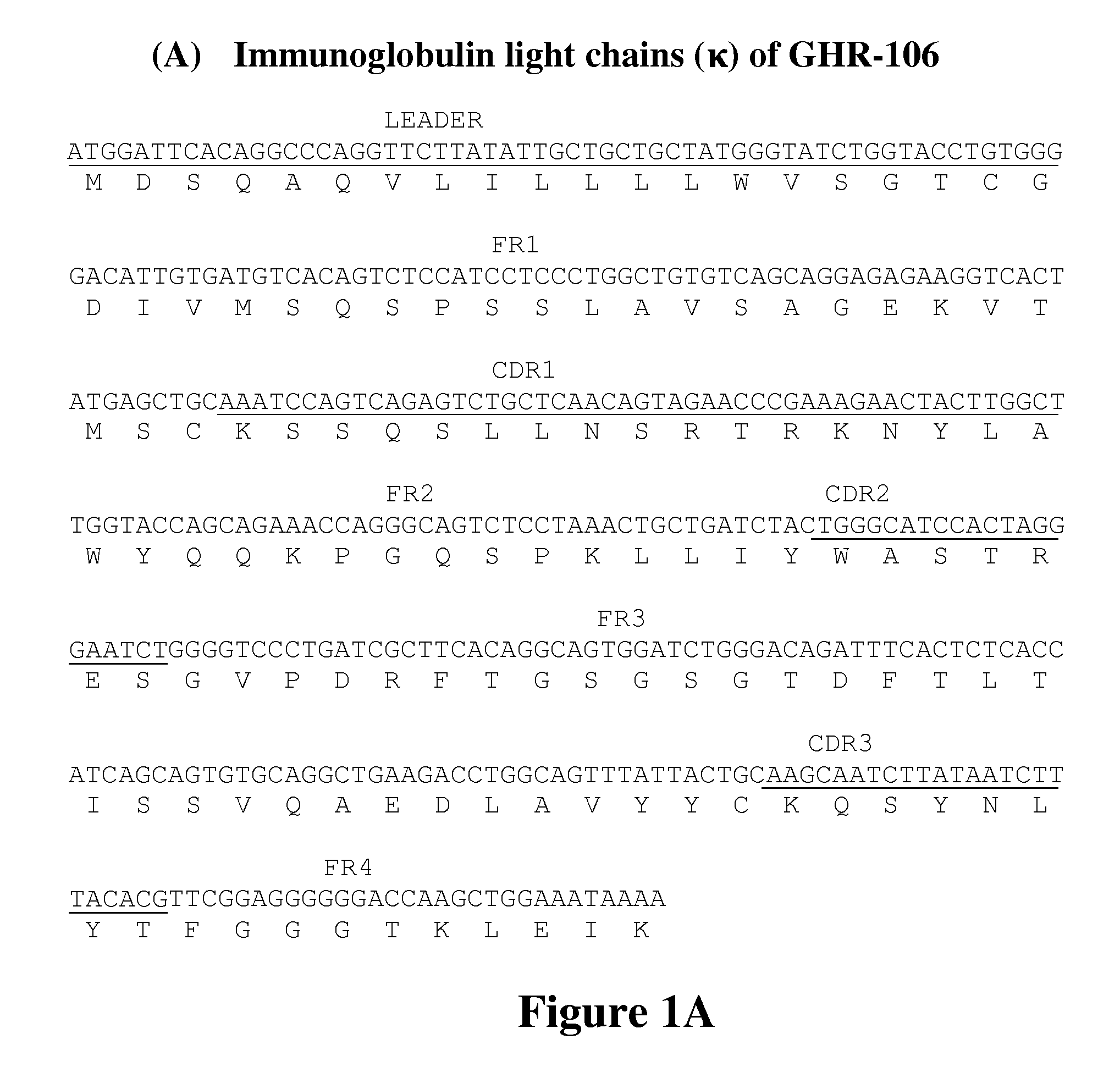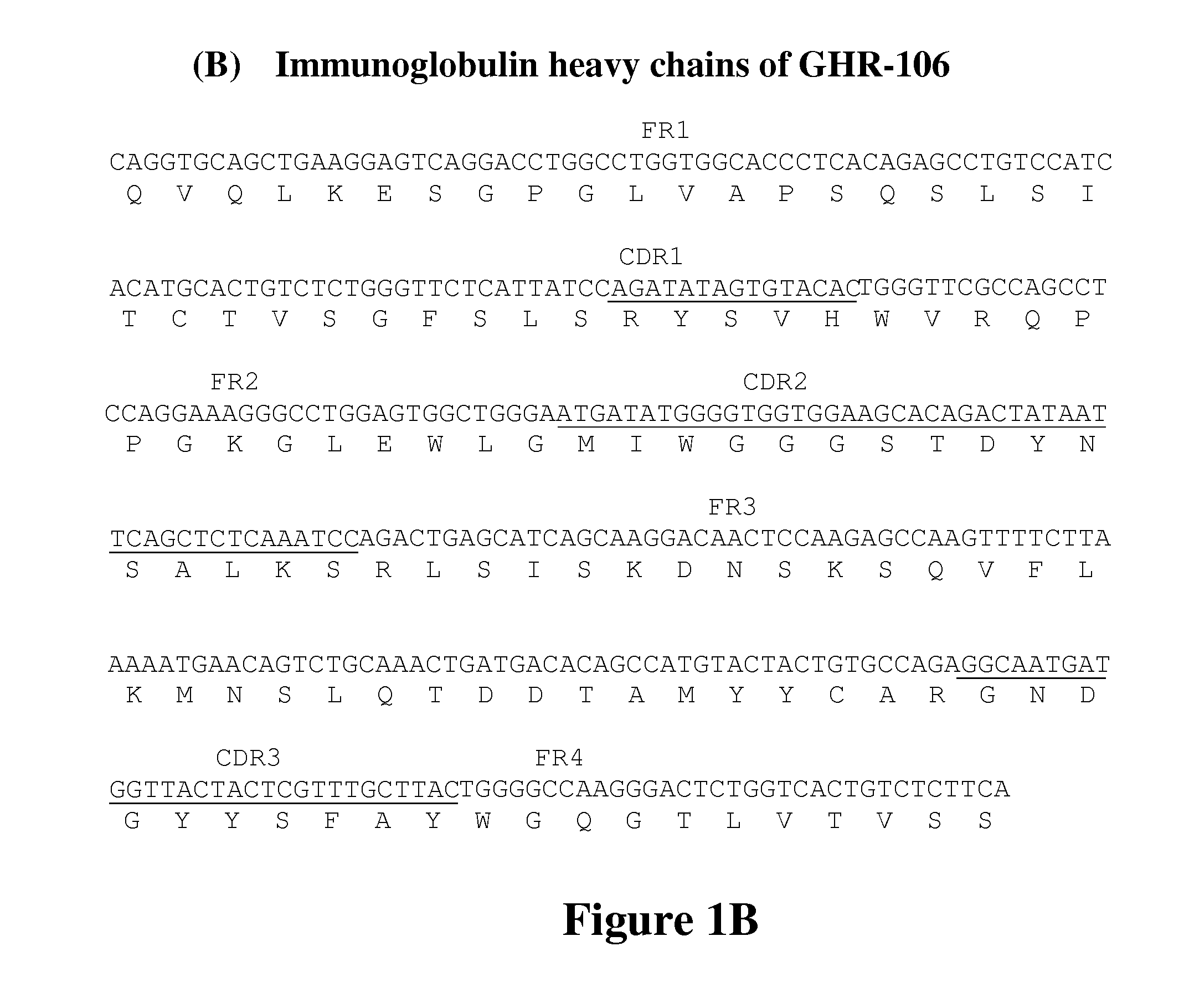Monoclonal antibodies against gonadotropin-releasing hormone receptor
a gonadotropin-releasing hormone and monoclonal antibody technology, applied in the field of cancer treatment and diagnosis, can solve the problems of limited and variable efficacy in many cases, limited efficacy of gnrh and its analogs, and inability to disclose the preparation of monoclonal antibodies or isolated antibodies useful in such treatments, and achieve the effect of altering reproductive functions
- Summary
- Abstract
- Description
- Claims
- Application Information
AI Technical Summary
Benefits of technology
Problems solved by technology
Method used
Image
Examples
example 1
Generation and Selection of Monoclonal Antibodies Against Human GnRH Receptor
[0068]Oligopeptides corresponding to amino acid residues 1-29, 182-193, 195-206 and 293-306 in the extracellular domains of human GnRH receptor were custom synthesized by Gemed Lab, South San Francisco, Calif. and Genescript, NJ, and conjugated separately to keyhole limpet hemocyanin (KLH) by standard methods. These conjugates were used as immunogens to generate monoclonal antibodies as previously described. Lee, G-C. Y., et al., Am J Reprod Immunol (2000) 44:170-177.
[0069]Several monoclonal antibodies were generated against the synthetic peptide corresponding to positions 1-29 in the extracellular domain of GnRHR. One of the monoclonal antibodies, GHR-106, was selected for further characterization. A murine hybridoma that secretes GHR-106 was deposited at the American Type Culture Collection, Rockville, Md. on Aug. 5, 2009 under the terms of the Budapest Treaty and assigned an ATCC®Patent Deposition Design...
example 2
Characterization of GHR-106 Monoclonal Antibody
[0071]Microwells coated with synthetic peptide or cancer cells were used to estimate the affinity constant between GHR-106 and GnRH receptor. Following one hour incubation at 37° C. with GHR-106 in microwells, goat anti-mouse IgG labeled with alkaline phosphatase served as the second antibody for signal detection with p-nitrophenylphosphate. As shown in FIG. 2A, GHR-106 showed dose-dependent binding to 1-29 synthetic peptide coated onto microwells. Similar dose-dependent binding was observed between GHR106 and OC-3-VGH cancer cells coated on microwells, as shown in FIG. 2B using the foregoing assay conducted under similar conditions.
[0072]Based on the results of these binding assays, the dissociation constant (Kd) was estimated to be 2×10−9 M.
[0073]Using the assay conditions of FIGS. 2A and 2B, GnRH I was shown to inhibit the binding of GHR-106 to OC-3-GH cancer cells coated on microwells using 2 μg / ml GHR-106. The decrease in relative ...
example 3
Induction of Apoptosis of Cancer Cells by GnRH and GHR-106
[0075]A. TUNEL Assay
[0076]In order to investigate the anti-proliferative effects (or apoptosis) of GHR-106 on cancer cells, In Situ Cell Death Detection Kit, POD (Roch, Canada) was employed for detection and quantitation of apoptosis at a single cell level. Briefly OC-3-VGH ovarian cancer cells were cultured in RPMI-1640 medium at 37° C. in a CO2 (5%) incubator for two to three days until all cancer cells are attached to microwells. Following removal of cell culture medium, fresh serum-free medium was added for additional 3 hours incubation in CO2 incubator.
[0077]After the serum-free starving period, the cells were incubated in fresh medium containing 10% fetal calf serum, GnRH or GHR-106 of known concentrations was added for co-incubation of 24 to 72 hours. As the negative control, normal mouse IgG of the same concentration was used for the same incubation period.
[0078]At the end of incubation, the attached cells were remove...
PUM
| Property | Measurement | Unit |
|---|---|---|
| Dissociation constant | aaaaa | aaaaa |
| Composition | aaaaa | aaaaa |
| Cell proliferation rate | aaaaa | aaaaa |
Abstract
Description
Claims
Application Information
 Login to View More
Login to View More - R&D
- Intellectual Property
- Life Sciences
- Materials
- Tech Scout
- Unparalleled Data Quality
- Higher Quality Content
- 60% Fewer Hallucinations
Browse by: Latest US Patents, China's latest patents, Technical Efficacy Thesaurus, Application Domain, Technology Topic, Popular Technical Reports.
© 2025 PatSnap. All rights reserved.Legal|Privacy policy|Modern Slavery Act Transparency Statement|Sitemap|About US| Contact US: help@patsnap.com



